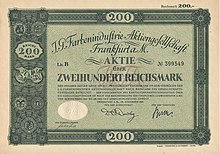
Back إي غه فاربن Arabic Фарбен Bulgarian IG Farben Catalan IG Farben Czech I.G. Farben Danish I.G. Farben German IG Farben Greek IG Farben English IG Farben Esperanto IG Farben Spanish
| I.G. Farbenindustrie AG | |

| |

| |
| Création | 1925 |
|---|---|
| Disparition | 1952 |
| Forme juridique | Société anonyme |
| Siège social | Francfort-sur-le-Main |
| Activité | Produits chimiques Raffinage du pétrole |
| Filiales | Hoechst ( - Guano Works (d) DK Recycling und Roheisen GmbH (d)[1] Deutsche Grube (d)[2] Buna-Werke[3] Gasolin (en)[4] WASAG (d)[5] American IG (en)[6] Braunkohlenwerke Bruckdorf (d)[7] Soja AG (d) Wagenmann & Seybel (d)[8] ACNA (en)[9] WCM Beteiligungs- und Grundbesitz-Aktiengesellschaft (d)[10] Deutsche Länderbank (d)[11] Interhandel (en) Deutsche Gesellschaft für Schädlingsbekämpfung[12] Agfa-Gevaert[13] BASF I.G. Bergwerke (d) Donau Chemie (d)[14] Behringwerke (d)[15] Leuna works (en)[16] Pulverfabrik Rottweil (d)[17] Bayer |
| Société suivante | BASF, Hoechst, Bayer et Agfa-Gevaert |
| modifier - modifier le code - voir Wikidata | |







L'abréviation IG Farben (où IG est l'abréviation du mot allemand InteressenGemeinschaft) désigne la société allemande fondée le sous le nom de IG-Farbenindustrie AG[note 1]. Une « petite IG », par opposition à l’IG de 1925, a été fondée en 1905 par rapprochement concerté des sociétés chimiques BASF, Bayer et Agfa. Un conseil de gestion commun fut créé, mais chacune des sociétés conserva son identité propre.
Jusqu'en 1945 au moins, le groupement d'intérêt économique IG Farben produisit de nombreux produits chimiques : ammoniac synthétique (duquel étaient dérivés des engrais azotés, des explosifs) et des biocides ou gaz d'exterminations dont le Zyklon B, de l'essence synthétique, des médicaments, des colorants, des plastiques, du caoutchouc synthétique, des pellicules photographiques et des textiles.
Cette société fut démantelée en 1952 dans le cadre de la politique de dénazification.
- Pressearchiv 20. Jahrhundert (organisation), [lire en ligne], consulté le .
- Pressearchiv 20. Jahrhundert (organisation), [lire en ligne], consulté le .
- Pressearchiv 20. Jahrhundert (organisation), [lire en ligne], consulté le .
- Pressearchiv 20. Jahrhundert (organisation), [lire en ligne], consulté le .
- Pressearchiv 20. Jahrhundert (organisation), [lire en ligne], consulté le .
- Pressearchiv 20. Jahrhundert (organisation), [lire en ligne], consulté le .
- Pressearchiv 20. Jahrhundert (organisation), [lire en ligne], consulté le .
- Pressearchiv 20. Jahrhundert (organisation), [lire en ligne], consulté le .
- Pressearchiv 20. Jahrhundert (organisation), [lire en ligne], consulté le .
- Pressearchiv 20. Jahrhundert (organisation), [lire en ligne], consulté le .
- Pressearchiv 20. Jahrhundert (organisation), [lire en ligne], consulté le .
- « https://www.loc.gov/rr/frd/Military_Law/pdf/Law-Reports_Vol-10.pdf »
- (en) « Flourishing in a dictatorship: Agfa's marketing and the Nazi regime », Journal of Historical Research in Marketing, Emerald Group Publishing (d), (ISSN 1755-750X et 1755-7518, DOI 10.1108/17557501311293361, lire en ligne) :
.« The purpose of this paper is to understand how Agfa, a division of IG Farben and Germany's leading producer of photographic equipment, adapted its marketing strategy to the new political environment created by the Nazi regime. This was a time when many consumer goods manufacturers suffered from the state‐driven reallocation of resources favoring the armament industry. Agfa, however, expanded its production well into the war. »
- Pressearchiv 20. Jahrhundert (organisation), [lire en ligne], consulté le .
- Pressearchiv 20. Jahrhundert (organisation), [lire en ligne], consulté le .
- Pressearchiv 20. Jahrhundert (organisation), [lire en ligne], consulté le .
- Pressearchiv 20. Jahrhundert (organisation), [lire en ligne], consulté le .
- Norbert Wollheim Memorial.
Erreur de référence : Des balises <ref> existent pour un groupe nommé « note », mais aucune balise <references group="note"/> correspondante n’a été trouvée